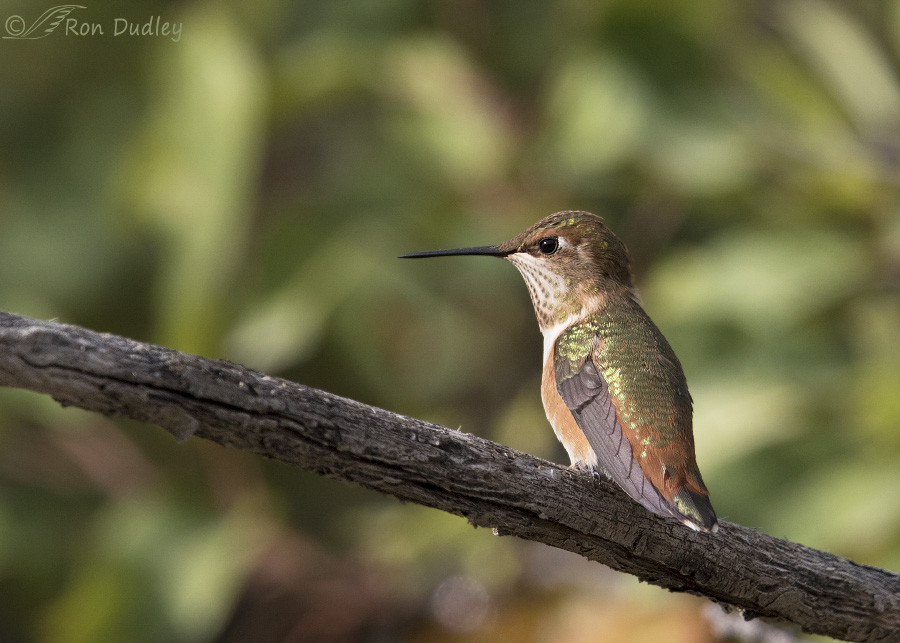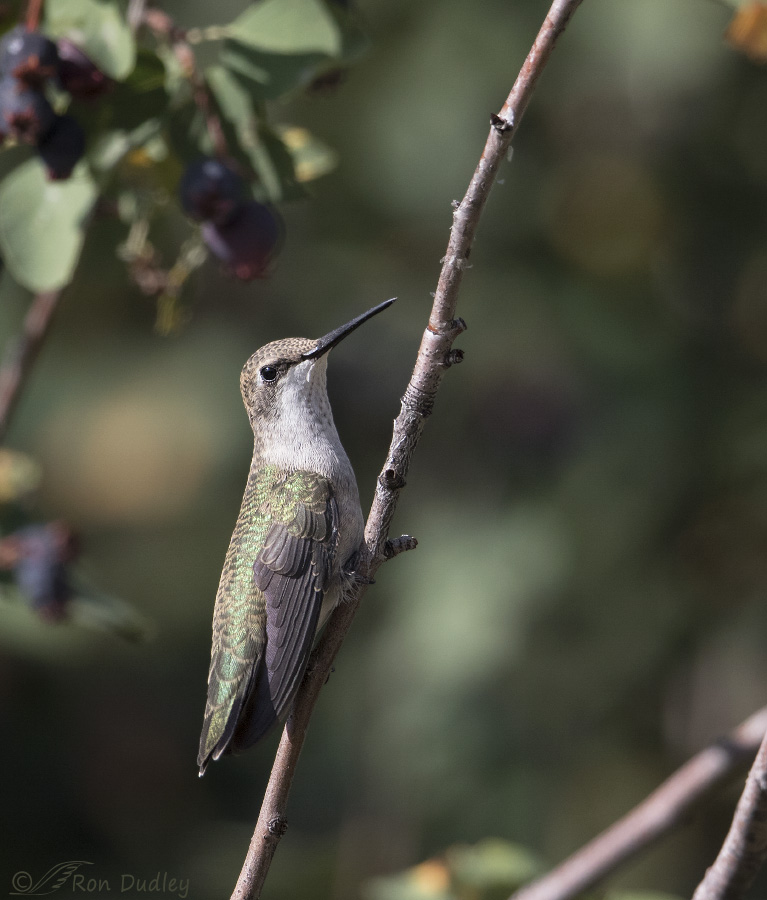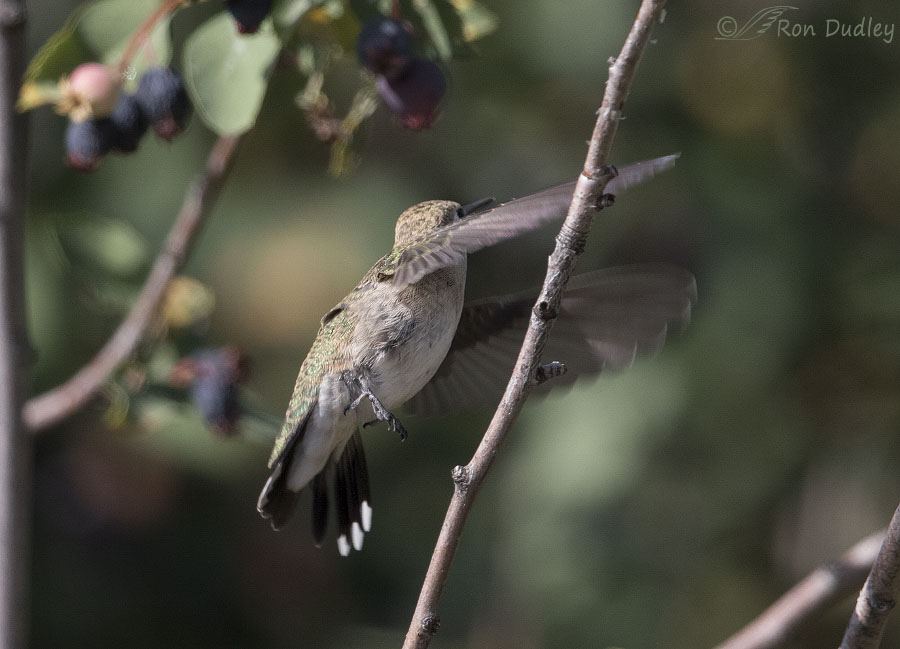And I’m stumped on the ID of one of them. A little help from my friends?
Yesterday I spent most of the morning photographing birds at a single cluster of berry bushes in the Wasatch Mountains. Berries of various species are unusually abundant this year and birds are taking full advantage. The shooting was tough because they spent most of their time buried in the bushes eating berries but over 2 hours and 15 minutes I had opportunities with at least thirteen species without moving from the same spot or even starting my engine. Can’t beat that!

1/4000, f/6.3, ISO 800, Canon 7D Mark II, Canon EF 500mm f/4L IS II USM + EF 1.4 III Extender, not baited, set up or called in
One of them was this Rufous Hummingbird that landed on a branch for a few moments and watched the feeding frenzy of other species. I do wish it had been a little closer but I like the dappled light in the background and the light on the bird.

1/2500, f/5.6, ISO 800, Canon 7D Mark II, Canon EF 500mm f/4L IS II USM + EF 1.4 III Extender, not baited, set up or called in
And this hummer seemed to do the same thing from a different, almost vertical perch. I’m struggling with ID on this bird so I’d appreciate some help from readers who are more hummingbird-knowledgeable than myself.
I often can’t get as close to hummingbirds in the wild as I’d like but I still much prefer images of them taken in wild settings than photos taken at feeders or even at back yard flowers. For me natural settings just can’t be beat, despite their “imperfections.”
Damn, it felt good to be photographing birds again! It had been 10 days since I’d been “out there” and I believe that’s the longest time I’ve gone without photographing birds in the last ten years except for when I went to Florida to be with daughter Shannon after her brain injury. I was definitely having withdrawal symptoms.
If I’m not careful this bird photography thing could become a habit…
Ron
Addendum: There’s been some discussion in the comments about whether this second bird is a female Broad-tailed or a female Black-chinned Hummingbird so here’s a shot I took of the bird as it took off away from me. I suspect this view, when combined with the previous one, might give some of my readers convincing evidence of which species it is.
Since I was asking for ID I probably should have posted both photos in the first place…



Very nice, Ron. The iridescence really shows in these images.
Thank you, Lyle.
Thanks for the second photo. With the tail spread, it’s clear now that this is a Black-chinned Hummingbird. They have have prominent white tips on the three outermost tail feathers, as can be clearly seen here. A Broad-tailed Hummingbird has prominent white tips on the two outermost tail feathers. The third feather in has a bit of white on the tip, but much less than on the two outermost feathers. Additionally, on a Broad-tailed Hummingbird there is strong cinnamon color at the base of the tail on either side of the rump. That feature is typically not visible until the bird spreads its tail or takes flight. In the second photo, it is clear that this feature is absent in this bird. So, Black-chinned is the best conclusion to make here, I believe. The overall paleness of this bird makes me think that it likely is a juvenile. If so, that would account for why I was mis-led by what appears to be a straight beak. In hummingbirds, the beaks continue to elongate until nearly the time of the first molt in the fall. If this bird’s beak is still growing, it likely has not yet reached its full length where some curvature (slight) will occur.
Size, quickness and similarity of plumage in females and juveniles can sometimes make hummingbird ID very challenging. A fascinating group of birds with many unique features. Because of size, we mistakenly think of them as fragile, but many are known to live 11-12 years. And they’re not all small. The Giant Hummingbird found high in the Andes (over 8,000 ft elev.) is larger than a Song Sparrow.
Dan, thanks very much for your detailed analysis. Based largely on what you said as far as I’m concerned the bird is a Black-chinned.
Wow, Dan! Thank you for such interesting information. I love to learn new things and I’m never disappointed coming here.
I second that, Marty. When it comes to birds Dan knows his stuff and he’s always been generous to share. Plus, I just like his style…
Thank you. I wish bird field guides would give this kind of information.
Deedee
Both fall firmly into (the very large) category of feathered enchantment.
Thank you, EC.
I have to mention, one thing I like about your post is the pin sharp quality of the photos. I like to enlarge the photos and look at the feather condition of the birds. For me I look at wear, mites, molt and over all condition. Its always amazing to see stress bars and irregular wear or molt.
Thanks, April. I wish I could say that all of my photos were sharp but sadly they’re not.
Just think of the detail you could see if you were looking at the high resolution version of the images…
Black-chinned is my guess. Please note the word “guess” I hate IDing juvies.
Beautiful shots Ron!
Charlotte
Thanks, Charlotte.
Well Ron, I would say a female Ruby Throated by reading Stokes book. Take your time to heal and don’t beat yourself up if you can’t do everything you want to do
Thank you, Shirley.
I am no expert on hummers, but looks to be a juvenile, it still has a baby look about it. The beak is still short and stout, there are new feathers still growing in on the wings and tail. At first I thought it might be a broad-tailed because the wing looks shorter than the tail in the photo, but if I enlarge the photo the wing is in the shadow and is as long as the tail which would lean toward black chinned. Did you have any other shots where the side under the wing is more visible? Broad-tailed tend to have more rust color sides than black chinned as juveniles. Black chinned are lighter white and grey on the sides chest and underbelly. Juveniles are hard to ID until the first molt. I hope this all made sense, I was interrupted mid-paragraph for a bird arrival with an police officer. They are concerned there is someone shooting hawks in the downtown area, she brought a dead coopers and wanted us to look to see how it died. Man I am getting old it is hard for my brain to change gears!
April, I’m about to post another photo of this bird that should clear up the confusion (for those who know hummer ID better than I do).
Ron, thank you for photos of my favorite birds. We have hummers in our back yard and they do chase each other, which is amazing to watch.
So glad you got out. The mountains around here can rejuvenate oneself. Seeing and photographing these hummers can add to that joy.
Thank you, Ron
Thanks, Alice. Yes, the mountains are rejuvenating, especially when it’s so damned smoky down here in the valleys. This morning our air down here is dreadful but it was almost clear as a bell in the mountains.
Let me suggest female Broad-tailed Hummingbird. Black-chinned have long bills that are slightly decurved at the tip and the wing tip nearly reaches the tail tip when perched. Also. the wings should be slightly curved. Broad-tailed Hummingbirds have straight bills and the tail extends well beyond the wingtips when perched. This bird appears to have a straight bill and longer tail. The wingtips may be in shadow so are difficult to see. Other photos or your observations could change that opinion and I seldom see either species (they don’t occur here) so I’m certainly willing to be overruled by those with greater familiarity, but my first impression was Broad-tailed.
OK, some of the things you mention about the bird had us scratching our heads too, Dan – that straight bill in particular. In a few minutes I’m going to post another photo that just might clear up the confusion.
Having tried and tried to take shots of our single species of Hummers, I know how difficult it can be, and for me is constantly. These are excellent shots Ron, and it is great you are back outside habitually doing what you love! Both shots are great, but I especially like the Rufous.
Thank you, Dick.
I’m thrilled that you were able to be out among your beloved birds yesterday! I’m grinning and not because we get to see dandy shots like these — that’s gravy.
Thank you to all who identified the female. The only thing I know about hummingbirds is that they don’t know the words. *Insert rimshot or groan here — your choice.* (As I was leaving the teachers’ supply store Thursday, I ran across a whole poster pack of delicious puns — you know I went back and bought it! I’m now ready for middle school! )
)
I was grinning yesterday too, Marty. In fact I enjoyed it so much I did the same thing this morning and I rarely go shooting on Saturday because I don’t like all the commotion of lots of people and traffic.
And such a terrible habit it would be… Interesting that the second one is a Black-chinned female. We have one of those who hangs around our yard – she likes the desert willows and the mesquites – but I guess I’ve never really seen her close enough for a long enough time to recognize the one in your photo. I’m glad you were finally able to get back out into the wild, and that you got Hummingbirds. They are so different from the raptors, and even the song birds like the Yellow Warbler.
Interesting that the second one is a Black-chinned female. We have one of those who hangs around our yard – she likes the desert willows and the mesquites – but I guess I’ve never really seen her close enough for a long enough time to recognize the one in your photo. I’m glad you were finally able to get back out into the wild, and that you got Hummingbirds. They are so different from the raptors, and even the song birds like the Yellow Warbler.
It may not be Black-chinned, Susan. More to come…
Yes I agree female black chinned .. yes love photographing them in natural settings..
Nice photos Ron. I was out back taking hummer photos in the early evening yesterday. We have four or five Anna’s flying all over the place, but our yard is ruled by the one Rufous. Anytime he sees any of the Anna’s landing on a plant or flower in what he considers his domain, he is there like a speeding bullet. The Ann’s get chased, but they are never afraid to try and try again. Glad Lisa identified the Black-chinned. As with sparrows, I have little confidence in my ability to ID hummers.
Everett Sanborn, Prescott AZ
Thank you, Everett.
Beautiful little ones! I agree with you in photographing them ‘in the wild’…especially when catching them sitting on branches. I found some frantically feeding at ‘JewelWeed’ in the woods…they still chase each other around even though there were large clusters of the flower all about! So funny to watch!
So funny to watch!
“I agree with you in photographing them ‘in the wild’”
Good to know I’m not the only one, Kathy. Relatively few hummer shots I see appear to be taken in a natural setting.
Ooh I knew that one. we have Black-Chinned Hummers here. Great shots. Glad to hear you got to get out a bit.
we have Black-Chinned Hummers here. Great shots. Glad to hear you got to get out a bit.
Beautiful! I love hummers tho we rarely get them – just coming through on their way back S in August. Gorgeous, feisty little things! Glad you were able to get back “out there” and they perched for you – they can be a REAL challenge. Got your answer PDQ! I tried to photograph a huge, gorgeous dragon fly over my pond a few days back – mid day – NOT a good thing to try with minimal results! We also have an abundance of berries this year – Old Farmers said something along the lines of “having a lot of snow the berries will grow” – usually the birds clean them out but not even close yet! 37 this morning – BRRRR! Can’t tell if it’s fog or smoke – the latter was REALLY bad yesterday.
We also have an abundance of berries this year – Old Farmers said something along the lines of “having a lot of snow the berries will grow” – usually the birds clean them out but not even close yet! 37 this morning – BRRRR! Can’t tell if it’s fog or smoke – the latter was REALLY bad yesterday.
Thanks, Judy. Our smoke mostly cleared out during the day yesterday and so far it’s looking pretty good out there but it’s hard to tell for sure because it’s still mostly dark.
But I’d sure take your temps this time of year. It’s in the low 60’s right now and the AC came on multiple times during the night. It’s supposed to be about 90 degrees this afternoon.
Temps are great except I have my house plants outside for the summer!
At first glance I thought it was a slightly odd looking Ruby-throat, which I’m used to seeing in the east, but once I remembered where you were it should be a Black-chinned. Great shots! Hummingbirds are such small targets and hard to fill the frame with, so I usually just ignore them. I should probably try photographing them more often!
Thanks, Xavier. Yes, they’re so small that most any other songbird being that close would fill the frame well enough but when it’s a hummer that just isn’t the case. And spotting them in the first place, especially when they’re already perched, can be a huge problem for my less than perfect eyesight.
The mystery bird is a female Black-chinned.
Thanks, Lisa.